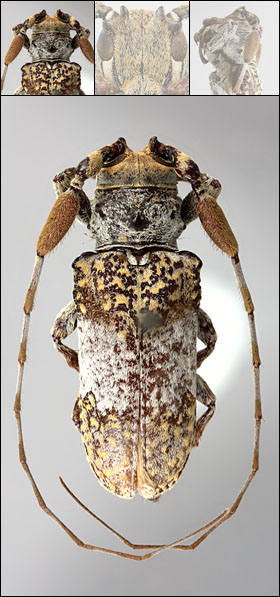 |
 Previous Genus Next Genus Previous Genus Next Genus 
Genus: Psyllotoxus
Diagnostic Features
- Description: Elongate-oblong, small to moderate-sized, ranging from about 11–16 mm in length. Integument generally dark brown or black with whitish, ferrugineous, and ochraceous pubescence.
 Head with frons subquadrate to elongate, about as wide as width of three lower eye lobes. Eyes with lower lobes ovate-oblong. Genae elongate, about as tall or distinctly taller than lower eye lobes. Antennal tubercles prominent, moderately separated; tubercles not armed at apex or armed with a short, blunt horn; antennae about as long as overall body length, or as much as twice as long; scape clavate, shorter than antennomere IV; antennomere III variable in shape and sexually dimorphic, from nearly straight to curved to sinuate (females) or strongly elliptical (males); antennomere III longer than scape and about as long or longer than antennomere IV; antennomere XI shorter than X (females) or longer than X (males). Pronotum transverse, roughly cylindrical to conical, distinctly narrower at base, with lateral tubercles; pronotal disk often with distinct glabrous area at center. Elytra with sides roughly parallel; elytral apices jointly rounded; elytra with distinct maculae; base of elytra with two prominent tubercles at humeri, often with several additional prominent, shiny tubercles. Basal 1/3 of elytra with dense punctation, surface granulate-punctate. Procoxae without projection or with an obtuse tubercle (males). Mesosternal process with apex subtruncate to feebly emarginate. Metafemora moderate to short in length, about 1/3–1/4 as long as elytra. Head with frons subquadrate to elongate, about as wide as width of three lower eye lobes. Eyes with lower lobes ovate-oblong. Genae elongate, about as tall or distinctly taller than lower eye lobes. Antennal tubercles prominent, moderately separated; tubercles not armed at apex or armed with a short, blunt horn; antennae about as long as overall body length, or as much as twice as long; scape clavate, shorter than antennomere IV; antennomere III variable in shape and sexually dimorphic, from nearly straight to curved to sinuate (females) or strongly elliptical (males); antennomere III longer than scape and about as long or longer than antennomere IV; antennomere XI shorter than X (females) or longer than X (males). Pronotum transverse, roughly cylindrical to conical, distinctly narrower at base, with lateral tubercles; pronotal disk often with distinct glabrous area at center. Elytra with sides roughly parallel; elytral apices jointly rounded; elytra with distinct maculae; base of elytra with two prominent tubercles at humeri, often with several additional prominent, shiny tubercles. Basal 1/3 of elytra with dense punctation, surface granulate-punctate. Procoxae without projection or with an obtuse tubercle (males). Mesosternal process with apex subtruncate to feebly emarginate. Metafemora moderate to short in length, about 1/3–1/4 as long as elytra.
- The combination of the following characters will help to distinguish this genus: moderately small eyes; widely separated; males with strongly elliptical antennomere III; pronotum with distinct lateral tubercles; and elytra with sides roughly parallel.
- Similar genus/genera: superficially resembles Eudesmus, Lochmaeocles, and Oncideres.
Geographic Distribution
Host Plants/Trees
- Caesalpiniaceae (Bahuinia sp.); Myrtaceae (Eugenia malaccensis, Myrciaria cauliflora, Psidium guajava [guava], Syzygium cuminii); Rosaceae (Malus sylvestris, Prunus domestica, Prunus persica [peach], Pyrus communis, Rosa sp.)
Girdling Behavior
- Members of this genus are known to girdle branches and P. griseocinctus is considered a pest species (Giacomel, 1992).
Notes
Generic Synonymies
Selected References
|
 |
 
Psyllotoxus griseocinctus
♂ specimen
© E.H. Nearns
|
© 2011-2015 Nearns, E.H., Lord, N.P., and K.B. Miller
The University of New Mexico and Center for Plant Health Science and Technology, USDA, APHIS, PPQ.
|


